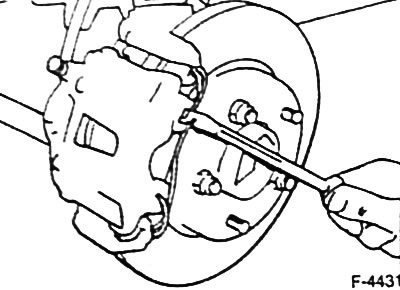Withdrawal
Mark the position of the front wheels on the capitals with paint. Thanks to this, the balanced wheel can be installed again in its original position. When loosening the wheel nuts, the vehicle must be on its wheels. Support the front of the car on a stand with goats and front wheels.

Use a screwdriver to pry the retaining clip from the caliper.

Remove protective caps from both guide pins. Using a 7 mm hexagon socket wrench, unscrew the caliper guides.
Disconnect the plug connector of the brake lining wear indicator sensor.
Remove the piston housing from the brake shoe guide.
Removed from the piston housing brake pads.
Attention. It is not allowed to rearrange the brake pads from the right wheel to the left. Repositioning the pads can result in uneven braking action. Brake pads of one bridge must be replaced only as a set. If disc brake pads are to be reinstalled, their location must be marked before removal.
Settings
Attention. With the brake pads removed, do not press the brake pedal, otherwise the piston will be pushed out of the housing.
Clean the guide surfaces or, respectively, the places of the pads in the housing shaft with a suitable soft metal brush or wipe with a cloth soaked in alcohol. Do not use solutions. containing mineral oils and tools with sharp edges.
Before installing the pads, examine the brake discs to the touch with your fingers for the absence of recesses. Notched discs need to be replaced.
Measure the thickness of the brake discs, see p. 114.
Check dust collar and caps for cracks. Replace a damaged cuff immediately, as penetrating dirt will quickly break the tightness of the caliper. To do this, the brake caliper must be disassembled (at the service station).

Bring the brake piston back into the caliper cylinder with a return tool. You can also use a hardwood rod for this (hammer handle), however, make sure that the piston is not skewed and that the surfaces of the piston and dust seal are not damaged.
Attention: When installing the piston in the cylinder, the brake fluid is squeezed out of the brake cylinder into the compensation tank. Monitor the fluid level in the tank and, if necessary, suck out excess fluid with a siphon.
For suction, use a plastic bottle that has previously only been in contact with brake fluid. Do not use bottles intended for drinking liquids! Brake fluid is poisonous and must never be sucked out by mouth through a hose. Suck out the liquid with a siphon. After replacing the brake pads, the level of the brake fluid in the compensation tank should also not exceed the MAX mark, since the fluid expands when heated. The brake fluid flowing out of the reservoir gets under the main brake cylinder, destroys the varnish coating and leads to corrosion.
Caution: If the brake pads are heavily worn, check that the piston can move freely. To do this, insert a wooden block into the caliper and ask an assistant to slowly depress the brake pedal. The piston should easily push out and slide back into the caliper wheel cylinder. When checking, another caliper must be installed in its place. Make sure that the piston is not completely pushed out of the caliper. If the piston stroke is heavy, the caliper must be repaired (at the service station).

Insert the inner brake shoe together with the retaining spring into the piston.
Remove the protective paper from the outer brake pad and insert the pad into the housing.
Insert the piston housing into the brake shoe guide.

Lay the connecting wire of the brake lining wear indicator sensor as follows. to prevent it from being rubbed off by the brake disc. Connect the plug connector of the brake lining wear indicator sensor.
Attach guide pins and tighten to 25 Nm. Install the protective caps on the guide pins
Insert the retaining clip into the brake caliper.
Screw the front wheels with nuts in accordance with the marks made before removal. Lower the vehicle and tighten the wheel nuts crosswise to 100 Nm.
Caution: Depress the brake pedal strongly repeatedly with the vehicle stationary until strong resistance is felt.
Check the brake fluid level in the expansion tank and, if necessary, top up the tank to the MAX mark.
Carefully run in new brake pads by repeatedly braking the vehicle from a speed of 80 km/h to 40 km/h by lightly depressing the brake pedal. Allow the brakes to cool down a little between braking applications.
Attention: On a section of the road up to 200 km in length, sudden braking to a complete stop should not be undertaken.
Visitor comments